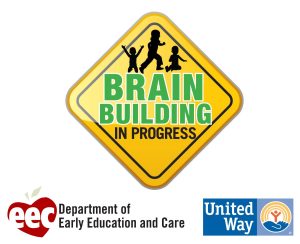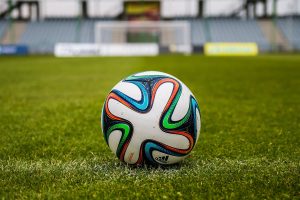12
Learning Objectives
After completing the reading and participating in the activities in this chapter you should be able to design an infant or toddler program with a) learning activities; b) schedule; and c) physical environment design using relationship-based practice to enhance cognitive development. NAEYC Standard 1c, 5a; MA Core Competency 5.A.2 @ Initial & 4.D.11 @ Initial )
Introduction
What is Cognitive Development? The Massachusetts Early Learning Guidelines for Infants and Toddlers (2010)[1] define cognitive development as
“… the process of learning to think and reason. Young children are learning not only knowledge, skills, and concepts, but also acquiring “learning to learn” skills” (p. 46).
Infants are naturally curious and learn through interaction with others and by exploring the environment. Piaget called this stage of cognitive development sensory-motor because infants and toddlers use all of their senses to explore their surroundings. Adults facilitate cognitive development by building positive relationships with children and families allowing infants and toddlers a secure base to explore the environment. Educators observe and encourage new learning to promote cognitive growth.
The specific skills for cognitive development are outlined in the MA Early Learning Guidelines are for Infants and Toddlers as, the infant or toddler will:
- Refine reflexes into purposeful actions (Infants)
- Develop memory skills.
- Demonstrate an awareness that predictable things happen as a result of actions..
- Develop problem solving skills.
- Explore materials and discover mathematical concepts.
- Develop early scientific skills through exploration and discovery.
- Discover creative expression through music, drama, dance and art experiences.
- Become aware of family and others in the community the foundations for social science.
As you can see, the area of cognitive development includes content areas of the curriculum such as math, science, the arts, and social studies or science. The chapter will include intentional teaching ideas to support learning in the content areas and to build brains.

How will you foster cognitive development?
The educator’s role is to discover the child’s needs and support their learning. As you read, consider how you can respond to children’s self- initiated explorations. Remember we should follow the child’s lead. How will you individualize the support you provide to promote cognitive development? For example, a 6-week-old child’s cognitive development is dependent on sensory-motor input and a 15-month-old’s learning is linked to the child’s level of trust and through relationships. How would you facilitate ball play with a 6 month old? With a 15-month old? For infants and toddlers, all developmental domains—— physical, cognitive, language, social and emotional—- are connected. Watch the video below for examples.
Video: Toddler Approaches to Learning
Watch this 7 minute video published on May 15, 2014 by All About Young Children to see examples of how children are learning to pay attention to people and things for ages 8 months to 18 months. Did you observe the toddlers using making choices and decisions; solving problems; interacting with others; pursuing their interest; building language and literacy skills; discovering mathematical concepts; and experiencing themselves as capable, competent, successful learners? How were the teachers intentional?
Infants are ready to learn from birth. They absorb information through touch, from the sights, sounds, and scents around them. They store, sort, and use this information to explore the world around them. Try to see the world from an infants perspective. Find a ball and explore the properties of the ball.
- What can it do?
- How does it move?
- How does it feel?
- What does it look like?

Photo from available from Pixabay: https://pixabay.com/en/the-ball-stadion-football-the-pitch-488717/
To learn more, read the article, Creativity, shared meaning, and relationships. Look for the answers to these questions:
- How can we assist infants and toddlers in their search for the meaning of things and the meaning of life?
- How can we respond to their constant questions, their ‘whys’ and ‘hows,’ with eyes that don’t see them as helpless or unknowing, but rather with eyes that acknowledge the quest to learn and to know?
School Readiness for Infants and Toddlers? Really? Yes, Really!”. explains the foundations of learning or habits of mind which include:
- Curiosity
- Attention
- Memory
- Problem Solving
- Persistence
- Information Gathering
Hopefully, you use habits of mind often because they are not limited to school environments but are life skills.. For example, in your role as an educator you might ask these questions:
- What is the most intelligent thing I can do right now?
- How can I learn from ______________?
- How can I draw on my past successes with problems like ______________?
- What resources do I have available or need to generate?
- How might I look at the situation in another way?
- What do I know or not know?
- What questions should I ask?
- What strategies are in my thoughts?
- What feelings or emotions might be blocking or enhancing my progress?
- What can I learn from others that would help me become a better problem solver?
Which habits of mind are easy for you? Which do you struggle with? How will you encourage children to develop effective habits of mind?
Teaching Tips
In each section below, I invite you to research and read articles that integrate theory and practice. You should find many ideas for your weekly activity plan and floor plan parts of the classroom design project.
Math
In Beyond Twinkle, Twinkle: Using Music with Infants and Toddlers, think about the ways you might use music to support cognitive development.
When reading, Infants and Toddlers Exploring Mathematics, focus on how intentionally using learnable moments to foster mathematical thinking. What language and questions might you use?
The US Department of Health and Human Services, Administration for Children and Families, Office of Head Start provides research and resources in the Early Childhood Learning and Knowledge Center (ECLKC). I invite you to visit ECLKC and in this chapter I included information about 2 specific articles. The first ECLKC article is Supporting Early Math Learning for Infants and Toddlers. Much of mathematical learning during infancy and toddlerhood involves vocabulary and language skills. Can you think of examples from observations of infants and toddlers where the educator or caregiver effectively used math concepts or math talk? I challenge you to make a list of math talk words and phrases.
Science
The second ECLKC article is News You Can Use: Early Science Learning For Infants And Toddlers. After reading the article, think about promoting the skills of inquiry with infants and toddlers? How did you answer the questions at the end of the article, in particular:
- Reflect on your experiences with science learning. Were they positive or negative? Can you say why?
- How might your personal feelings about science affect how you support early science learning for infants and toddlers?
- How might early science learning look the same or differently for young infants, older infants, and toddlers?
- How do you or will you support early science learning for infants and toddlers?
The Arts
Children’s Developmental Benchmarks and Stages: A Summary Guide to Appropriate Art Activities. is a helpful chart to help you plan music, movement, theater or dramatic play, and visual arts to your weekly plan. Can you think of activities and materials that will support learning about movement and dance, music, theater (dramatic play), AND the visual arts?
Read the article Let’s Get Messy: Exploring Sensory and Art Activities with Infants and Toddlers available on Blackboard and at the BSU library. What arts and sensory ideas might you try? The articles are available on Blackboard and at the BSU library.
Social Studies
Social studies during infancy and through toddlerhood can be summarized as the movement from feelings to friends. Think about how you will promote social and emotional development in the context of building community in your classroom. To begin thinking about the content area of social studies. Read Social Studies in Today’s Early Childhood Curricula which offers an overview of social studies for children from infancy through school-age so you will know how the skills you foster with infants and toddlers will be helpful to later learning. When reading, focus on answering:
- How will you build on what children already know and capitalize on their interests?
- How will you develop concepts and processes of social studies?How will you provide hands-on activities?
- What will you add to your weekly planner?
I invite you to read 2 articles from the July 2015 NAEYC journal Young Children titled: Social Studies: From a Sense of Self to a Sense of the World. First read, It Takes Two. In the article, Gillespie discusses the importance of self-regulation to learning to be an effective group member. Next read, Museum Babies: Linking Families, Culture, and Community where you can learn about using community resources and specific activities to include in your weekly plan. The last article to read is Using Children’s Books as a Social Studies Curriculum Strategy. What books might you add to your classroom library to promote learning social studies concepts? The articles are available on Blackboard and at the BSU library.
Remember
“In high-quality infant/toddler programs, the interests of the child and the belief that each child has a curriculum are what drive practice” (Lally, 2000, p.6)[2]
References and Resources
Early Head Start National Resource Center, News You Can Use. (May, 2014) Early Science Learning for Infants and Toddlers. Washington, DC: US Department of Health and Human Services, Administration for Children and Families, Office of Head Start.
Early Head Start National Resource Center, News You Can Use. Supporting Early Math Learning for Infants and Toddlers (October, 2012) Washington, DC: US Department of Health and Human Services, Administration for Children and Families, Office of Head Start.
Geist, E. (2009) Infants and Toddlers Exploring Mathematics, Young Children, 39-42. Available on Blackboard
Gillespie, L. (2015). It Takes Two. YC: Young Children, 70(3), 94-96.
Goble, C. B., Wright, S., & Parton, D. (2015). Museum Babies: Linking Families, Culture, and Community. YC: Young Children, 70(3), 40-47.
Let’s Get Messy!. (2012). YC: Young Children, 67(4), 26-34.
Meléndez, L. (2015). Using Children’s Books as a Social Studies Curriculum Strategy. YC: Young Children, 70(3), 48-53.
Mindes, G. (2005) Social Studies in Today’s Early Childhood Curricula. Beyond the Journal, NAEYC.
National Association for the Education of Young Children. (2004) Children’s Developmental Benchmarks and Stages: A Summary Guide to Appropriate Art Activities. Beyond the Journal: Young Children
Parlakian, R., & Lerner, C. (2010). Beyond Twinkle, Twinkle: Using Music with Infants and Toddlers. YC: Young Children, 65(2), 14-19.
Petersen, S. (2012) School Readiness for Infants and Toddlers? Really? Yes, Really!” Young Children, 10-13
Rinaldi, C. (2006). Creativity, shared meaning, and relationships. In Lally, R., Mangione, P., and Greenwald, D. (Eds.), Concepts for Care (pp. 21-23). San Francisco, CA: WestEd.
- Massachusetts Department of Early Education and Care. (2010, November). Massachusetts early learning guidelines for infants and toddlers. Boston, MA: Author ↵
- Lally, J. R. (2000). Infants have their own curriculum: A responsive approach to curriculum planning for infants and toddlers. Head Start Bulletin, 67, 6–7. Retrieved January 4, 2008, from http://eclkc.ohs.acf.hhs.gov/hslc/ ecdh/eecd/Curriculum/Definition%20and %20Requirements/edudev_art_00101_072305.html ↵
